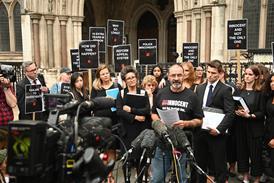The Brexit negotiations are now approaching another climax, as each side engages with its substantive positions on the transitional agreement and free trade agreement.
The EU has been laying out its position for weeks in a series of publicly available slides, posted alongside its negotiating documents. They deal with many of the most important issues, such as regulation and mobility. The services slides, published earlier this month, affect us most closely as lawyers – indeed they specifically mention us several times.
The first thing the EU makes clear is that the EU’s substantive rules on services are part of what it calls ‘a broader ecosystem’, described as follows:
- A distinct and unified legal order
- The supremacy and direct effect of EU law
- Its integration into national legal orders
The ecosystem is maintained in a number of ways: supervision and enforcement of the EU’s legal order, such as through administrative cooperation (the Internal Market Information system, IMI, for instance; a system of centralised oversight by the European Commission and networks of national supervisors in some areas; judicial enforcement, both by the Commission itself as guardian of the Treaty, with its ability to initiate enforcement action, and by the Court of Justice of the European Union (CJEU) in cooperation with national courts.
These details highlight the extreme difficulty of realising the Law Society’s chief aim in the Brexit negotiations, which is to continue with lawyers’ current practice rights in the EU in the post-Brexit era. Given the UK government’s wish, confirmed last week, of withdrawing from the ecosystem, it remains a challenge to see how the Law Society’s goal can be achieved.
The services slides mention the privileged regime under which lawyers practice in the EU. Along with statutory auditors, we are the only profession with sector-specific legislation. The monopoly of appearance by EU or EEA lawyers before the CJEU and EU intellectual Property Office is also mentioned.
If we do not stay within the ‘distinct and unified legal order’, how can UK lawyers’ practice rights develop in line with free movement legislation, or be affected by initiatives in other parts of the ecosystem of which the UK will not be a part, or be enforced? At best, it will not be EU practice rights, but a version frozen at the time of withdrawal.
Unless some miracle is achieved in the specific legal provisions of the withdrawal agreement – a miracle because what was announced as going into the withdrawal agreement in December expressly excluded the bulk of our current practice rights – these matters will have to await the future free trade agreement (FTA). We will find out later this week if the miracle has taken place, since the first draft of the legal provisions will then be published.
If there is no miracle, the Commission’s services slides detail the kind of future trade deal which might be negotiated. Focusing on the one which both sides seem to speak of most often as respecting the UK’s red lines – the FTA with Canada, the Comprehensive Economic and Trade Agreement (CETA) – the Commission explains that the route for practice rights in an EU-negotiated FTA is via a ‘framework for the recognition of professional qualifications’.
In the single market, mutual recognition operates by default, but in FTAs it is negotiated profession by profession. It is not commonly laid out in the FTA itself, but is negotiated afterwards. In other words, the EU’s FTAs include a framework providing an opportunity for the parties to negotiate a mutual recognition agreement (MRA) at any time after the FTA comes into force, and in any profession. The FTA does not oblige the parties to negotiate, nor does it shortlist the professions covered, nor guarantee the conclusions of any MRA in the future.
After the FTA, there will be a two-tier approach: first, the professional associations will submit a joint recommendation to the relevant body established under the FTA, and then the parties – in this case, the UK government and the EU – will assess the recommendation in the light of criteria defined in the FTA and either adopt the MRA or renegotiate it.
The EU notes that, so far, there have been no concluded MRAs in any FTA it has negotiated, although there is strong interest expressed within the context of CETA and the EU-Korea FTA.
I wrote in December that this would be the likely future. If it is, it means we would have to engage with the Council of Bars and Law Societies of Europe (in which we are combined into the UK Delegation with professional bodies from the other UK jurisdictions, which do not always have the same FTA interests as English solicitors), and work with sometimes competitive EU bars to obtain the best possible post-Brexit deal.
There is a long road ahead.



























1 Reader's comment